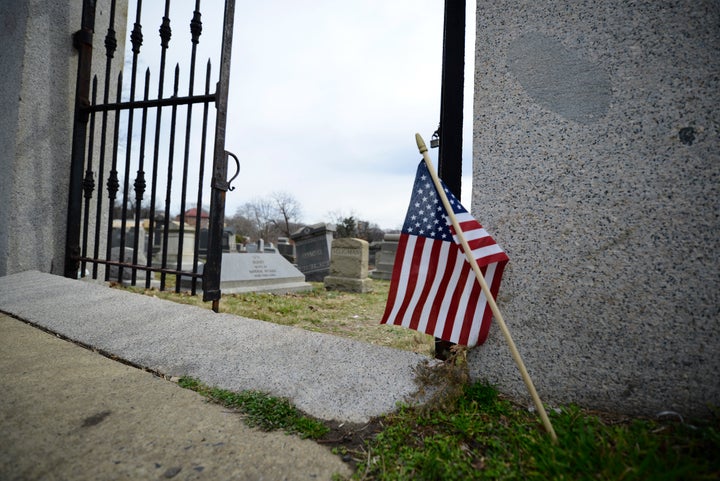
Purim will be a little different for American Jews this year. The raucous celebration of Mordecai and Esther’s triumph over Haman, quintessential “enemy of the Jews,” comes against the background of a rash of bomb threats targeting Jewish community centers, vandalism of several Jewish cemeteries, and an increased and emboldened anti-Semitic presence on social media (including tweets sent to and by teens). There seems to be a growing sense in some quarters that the well-being of Jews in the United States may not be as secure as most of us had imagined. Uncertainty about the seriousness of the current upsurge is part of what is causing the anxiety. One wants to know who the enemies are and how dangerous a threat they pose. In the Purim story, Haman’s wicked designs are clear and his downfall thankfully swift. Neither seems the case right now.
Item: My cousin bicycles out to the Mt. Carmel cemetery in Northeast Philadelphia, where over a hundred headstones have been overturned by vandals. Our great-grandparents are buried there, along with several recently deceased cousins. He finds the family’s graves untouched, but is shaken by the sight of the many stones that had been desecrated. Attacking the dead seems an extreme act of bullying: symbolic violence that, even though it does not actually hurt anyone, sends a message that we are all vulnerable, and ultimately defenseless. The Bible associates Haman with Amalek, the tribe who attacked the weak and tired among the Children of Israel on their way out of Egypt. Damage to a handful of cemeteries across the country is no reason for general panic among Jews. But it does cause one to shudder.
“There seems to be a growing sense in some quarters that the well-being of Jews in the United States may not be as secure as most of us had imagined.”
Item: A friend, parent to three small children, wonders how many bomb threats will be received by JCCs around the country (there have been 90 in the past month, at last count, affecting facilities in 30 states) before an actual bomb is discovered. How much risk should parents take before securing safer classrooms for their kids? What should we advise them? One press report includes the harrowing image of children evacuated to parking lots in the freezing cold. It was a relief to learn late last week that calls to several of the JCCs had been made by the jilted romantic partner of an employee, not necessarily anti-Semitic in motivation; culprits in the other cases remain unidentified. Jewish institutions of all sorts across America, including JTS, have heightened security. They have no choice but to be cautious.
Item: A rabbi who moved to Whitefish, Montana, with her family several years ago, in search of a quieter life outside the bustle and tension of the New York area, calls to let me know what it is like for the Jews in town to be harassed and intimidated week after week by neo-Nazis and other white supremacist groups. Their home addresses and pictures of their children have been posted on neo-Nazi websites. This was not supposed to happen in America, even in places like Montana where Jewish communities are tiny. New York too is not immune to the current wave of anti-Semitism. The NYPD announces that 100 hate crimes have been reported so far this year, compared with 47 during the same period last year; 55 of the 100 were aimed at Jews or Jewish institutions, compared with 19 in the prior period. There have as yet been no arrests. JCCs, cemetery vandalism, harassment: the various incidents could be unrelated—or they could form part of a single pattern. “You started with the hostile tweets,” said a former director of intelligence analysis for the NYPD. “You moved to the bomb threats... and now you have a physical manifestation at the cemeteries with the gravestones knocked over.”
“The consensus among scholars is that modern anti-Semitism... is different from the sort of attacks recounted in the Purim narrative.”
The consensus among scholars is that modern anti-Semitism—whether it emanates from the political left or from the right; whether it benefits from government sponsorship and support, as it did in czarist Russia or Nazi Germany; or whether it wells up from discontented masses and populist movements, as in 1930s America—is different from the sort of attacks recounted in the Purim narrative. It’s different from the kind of medieval persecution detailed in a recent study of late 14th-century Spain by my JTS colleague the historian Benjamin Gampel. In that case, Gampel writes, the mobs that attacked Jews were motivated by economic circumstances and inspired by religious fervor; the royal family who had sworn to defend the Jews decided to let them be slaughtered. Jews with special access to the court pleaded in vain for the lives of their fellows, including members of their own families. “The safety of the Jews was simply one of many interests that competed for [the attention] of those with the power to guarantee it,” Gampel writes.
Gampel knows that 1391 Spain is not the same as 2017 America—but he also believes that lessons from medieval Jewish history are more widely applicable. “That the safety of a minority cannot be assured,” he writes, is “a truth about the fate of all people and of all groups whose security is dependent on others.” It is a lesson we should heed—whatever the distinctiveness of modern varieties of anti-Semitism, and the differences between the Jewish situation and that of other groups. Jews have learned again and again that when others are persecuted, attacks on Jews will likely be forthcoming—and vice versa. When Haman’s plans to harm the Jews were proclaimed in Shushan, the Book of Esther reports, the entire city was concerned, with good reason.
Many Jews breathed an audible sigh of relief when the president denounced the cemetery vandalism in his address to Congress and the vice-president joined in the clean-up of desecrated graves in St. Louis. It turns out that Philadelphia cemeteries have been vandalized on several occasions over the years, and Mt. Carmel, according to one local news report, has long been the site of “low-grade desecration as teens party there, leaving behind beer bottles and other trash.” Could that be the case this time as well? For the moment, we just don’t know, as we don’t know the perpetrators of most of the bomb threats to JCCs. It seems far too soon to declare a crisis; the declaration of a prominent Israeli politician that Israel should prepare for mass aliyah from America seems premature at best—and, I think, a woeful misunderstanding of the degree to which Jews remain at home in this country and, according to every survey, enjoy unparalleled respect from Americans of other faiths and ethnic backgrounds.
JTS stands with the Jews who have been targeted in this outbreak of anti-Semitism, and offers its support to those made anxious and on edge. We are confident that our community, which has weathered many storms over the years, will come through this one with undiminished strength; we know that the best spiritual defenses against the anti-Semites is knowledge of Jewish tradition and Jewish history, and the pride that such knowledge engenders. The teens with whom I studied the Purim story last weekend at JTS’s Prozdor program were looking forward to the usual round of hamantaschen, Purim shpiels, and noisemaking every time Haman’s name comes up during the chanting of the megillah. They seemed unshaken by the recent spate of anti-Semitism, though I did detect a mature sobriety and wariness. That is an example that I hope all of us will follow.
